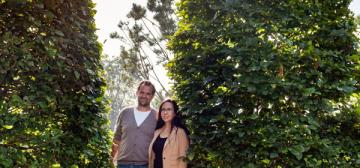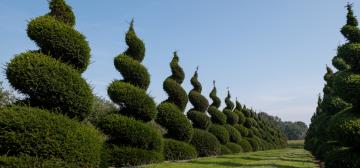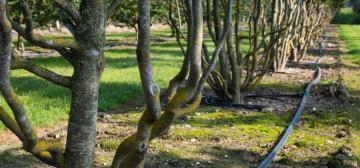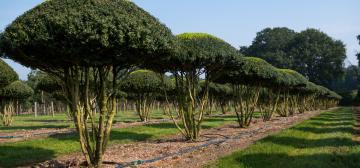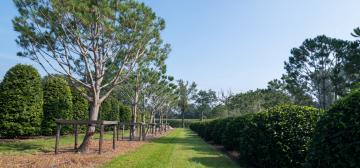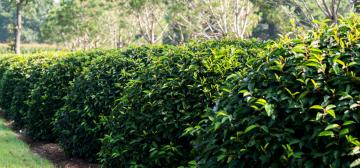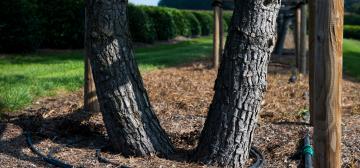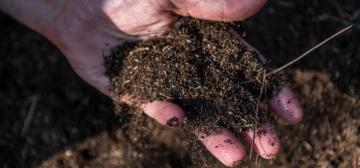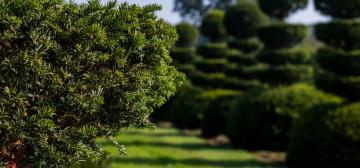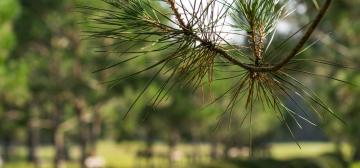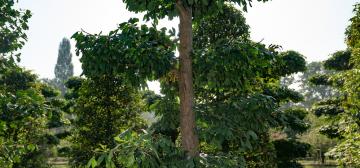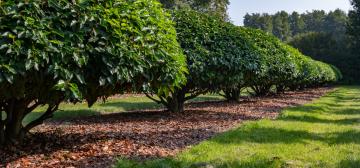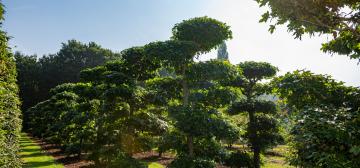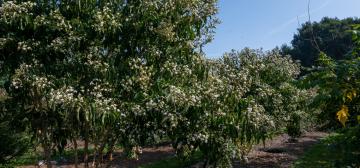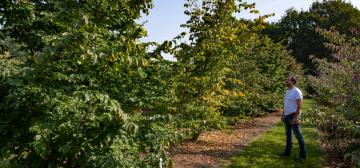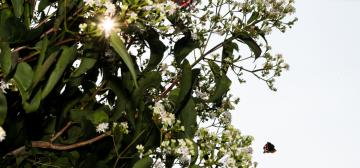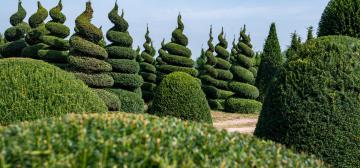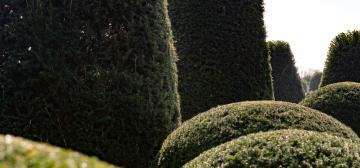Seeing the plant quality change is the biggest motivation
Big, spectacular, solitary trees full of character, that’s what you’ll find at Mentens tree nursery in Meeuwen. Year after year and step by step, owners Mariëlle and Bart are working towards more ecological cultivation. Samples and analyses are combined with common sense and faith in nature.
In 2019, Mariëlle Mentens and her husband Bart definitively took over the tree nursery from her parents. Initially, Mariëlle’s father also had an activity in garden landscaping and selling to private customers, but he abandoned them to focus on growing. Today, the company covers a surface area of 100 ha with met hedge plants and solitary plants. The hedge plants include specialities such as Prunus lusitanica, Osmanthus burkwoodii and Taxus baccata. But the company is better known for large sizes of exceptional shapes. Trees with character and multi-stem trees, shaped or not. The company has 24 employees. “We are trying to mechanise, but a lot of skilled work remains at the company that is difficult to replace by machines,” Mariëlle explains.
Considered action
No rushing but considered action, that is the management’s leitmotif. “Here we have plants that can easily be present at the company for 15 to 35 years. But if they are treated carelessly, it can all be over in 20 seconds. Of course we want to avoid that,” says Mariëlle. So attracting and keeping skilled employees is a must.
However spectacular the large, shaped plants look above the ground, it’s in the soil that the quality of the plant really takes shape. “Ten months a year we work on undercutting and transplanting. We think it’s really important to get the root system right and we want plants with lots of fine root hairs. Moving from poor to rich soil or vice versa yields a stronger plant.”
Giving advice
Transport takes a lot out of plants and their root systems, especially if it concerns transport far away towards the outer borders of the EU. The Netherlands, the United Kingdom and Switzerland are common destinations, but trees have also been sent to Turkey and Russia. Plants destined for long transport are not taken out of the ground until the last minute. Before they leave, the leaves are treated with an anti-transpirant. “We do everything possible to get the plant or tree to its destination unscathed. We prefer to sell one tree that does well than two trees one after the other because one has died due to incorrect handling. That really doesn’t make us happy. And that’s why we always give clear advice as to how to treat a certain tree. Our professional clients have a lot of know-how and passion, but keeping that up to par is a point of concern for the sector.”
Watering
When asked for the most common reason why trees sometimes still die after they reach the client, the answer is clear. “Too dry. Newly planted trees need a lot of water, especially during dry summers like those we have seen over the past few years. Private customers sometimes forget that.” Dryness is a greater evil than heat. “Last year we transplanted even at 33°C. The thing then is to keep the period that the plant’s out of the soil as short as possible and to water it enough.”
Own green oasis
Although trees can suffer from drought and heat, they are also part of the solution. “Trees give off oxygen and coolness. People once again think greenery is very important, both here and in the south of France or Turkey.” During the corona lockdowns, people wanted to create their own green oasis. Hedges and climbing plants offering more privacy did well on the domestic market. Large, solitary trees are opted for less for parcelling in smaller lots, but there is an enormous demand for larger, older trees full of character or multi-stem trees on the domestic market. However large sizes and exclusive trees do continue to do well internationally.
Grass strips
At the nursery, the ‘water status’ of the soil is very important. “We’re lucky to have sandy loam. But apart from the soil type, a good organic matter content also ensures that a lot of water can be retained.” Between the rows of large, solitary trees, grass strips have been created. “The grass strips retain the water below. In early summer we let the grass grow. It then forms a biotope for useful insects. Once mown, we leave the clippings. In the autumn, the grass prevents us from breaking the structure when drive over it with machines.”
Analyses as a cornerstone
Getting organic matter into the soil is easier said than done. To this end, tree nursery Mentens uses amongst other things ground leaves (leaf mulch) from park maintenance departments. “We’re satisfied with it until now, but we continue to evaluate. Does it help, what effect does it have on the pH, what is the long-term effect, etc. We use our common sense, but also carry out analyses and ask for advice from institutions that carry out field trials.”
The analyses at the company are no formal exercise but a cornerstone of the management. “We see analyses of plants’ soil like take blood samples in humans. It helps us know whether there are deficiencies somewhere, or if we are giving too much of something. This also prevents waste and unnecessary costs. We don’t look only at the basic elements, but also at trace elements such as copper, magnesium or silicon. We’ve noticed that deficiencies in these elements lead to more susceptible plants.” The basic fertiliser is farmyard manure mixed with soil under the root ball during transplanting. Artificial fertiliser is no longer used, nor are fertilisers in coated pellet form.
Natural development
Analyses do their thing, but old practices also still prove their worth. Things like leaving land fallow for example. “It’s not always easy to fallow, especially with the high land prices. But we have gained experience with it during the past few years, and the experiences are positive. By simply letting the natural weeds develop, you are creating the best biotope for useful insects during cultivation. We feel it’s even better than sowing green manure or flowers in buffer strips.” It doesn’t take long for the whole field to be covered. Just before cultivation, the vegetation that has gown there is ground up and dug in. Grass strips then suppress the weeds, just like the leaf mulch that is spread on top of the soil. The weeds that do come up can almost always be kept under control mechanically, sometimes even with a simple rake.
Butterfly friendly
So, things can be a bit more natural at the company; the standards have changed. “Now our reasoning is often the other way around. Is soil life even possible in soil without even a hint of weeds? In any case we are opting for a different way. The Natuurpunt nature conservation organisation told us that they had only found a certain butterfly at our nurseries during the summer of 2020. Which shows that we are succeeding in our aim to create a natural biotope.”
If it is necessary to resort to chemical crop protection, this occurs locally in low doses. Compared to three years ago, the tree nursery is using only a quarter of what it did then. And all that effort is paying off. “Less chemicals leads to stronger plants. Where we used to see thin soil, we now see a very lively biotope with strong plants. Land that we leave fallow pays for itself. But it’s work that takes years.”
Organic target
In 2021, 95% of the fertilisers Mariëlle used at the company were organic. “Our aim is to evolve towards ecological and perhaps in the long term even organic cultivation. We’re not yet certain we can achieve this fast for 100%, but we are using it as a target for where we want to go.”
For the future, Mariëlle and Bart still want to invest in solar panels and electric vehicles. An own water catchment system will further optimise the water supply. “We’re proud of how far we’ve come, but we don’t think that we’ve arrived already. We’re on the right path ecologically speaking, but we can still improve. We try to work out what is feasible and what isn’t. Often that’s a question of trial and error, but there’s no doubt about where we’re going.”
Tree nursery Mentens in figures
Employees
- 2 managers
- 5 permanent employees
- 19 contractual workers
Company surface area: 105 ha
Export: 52% of the turnover
- Great Britain: 12-15%
- The Netherlands: 10-12%
- Germany: 8-10%
- Export outside Europe: differs from project to project
